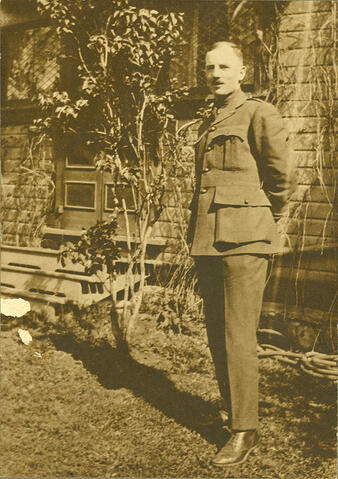
Title and statement of responsibility area
Title proper
Reginald J.G. Bateman - In Uniform
General material designation
- Graphic material
Parallel title
Other title information
Title statements of responsibility
Title notes
Level of description
Item
Reference code
Edition area
Edition statement
Edition statement of responsibility
Class of material specific details area
Statement of scale (cartographic)
Statement of projection (cartographic)
Statement of coordinates (cartographic)
Statement of scale (architectural)
Issuing jurisdiction and denomination (philatelic)
Dates of creation area
Date(s)
-
[between 1914-1918] (Creation)
Physical description area
Physical description
1 photograph : sepia ; 20.5 x 26 cm
Publisher's series area
Title proper of publisher's series
Parallel titles of publisher's series
Other title information of publisher's series
Statement of responsibility relating to publisher's series
Numbering within publisher's series
Note on publisher's series
Archival description area
Name of creator
Custodial history
Scope and content
Reginald J.G. Bateman, Professor of English, standing in the uniform of the [Canadian Expeditionary Force] in front of a building.
Bio/Historical Note: Reginald John Godfrey Bateman was born on 12 October 1883 in County Kerry, Ireland. He received his early education at Royal School, County Fermanagh, and both his BA (1906) and MA (1909) from Trinity College. Shortly after graduation in 1909 Bateman immigrated to Canada and was hired as Professor of English at the University of Saskatchewan. He enlisted as a private in the 28th Battalion, Canadian Expeditionary Force (CEF), in September 1914 and served in France. In early 1916 the idea of a Western University Battalion took root. Initially the Canadian military was reluctant, but the combination of a strong lobbying campaign and the need for fresh troops to replace the mounting casualties in Europe tipped the scales. Bateman was sent back to Canada to raise a company of the 196th (Western Universities) Battalion. The 196th was to consist of a company from each of the four western provinces. Once formed, it trained at Camp Hughes in Manitoba and was then sent to England. The 196th’s history was brief. Once in England it was broken up to reinforce existing units. A high portion of the recruits eventually found themselves in the officers’ ranks. Many found themselves assigned to the Saskatchewan-dominated 46th Battalion. Also known as the "Suicide Battalion," it fought in some of the bloodiest encounters of the war. Reinforcements were constantly needed as battle after battle decimated its ranks. Of the 5,374 men in the 46th Battalion, 4,917 were either killed or wounded. With the end of the war came demobilization and the end of the 46th Battalion. Reginald Bateman did not return. He was killed near Dury, France on 3 September 1918.
Notes area
Physical condition
Immediate source of acquisition
Arrangement
Language of material
Script of material
Location of originals
Availability of other formats
Restrictions on access
Terms governing use, reproduction, and publication
Copyright: Public domain
Other terms: Responsibility regarding questions of copyright that may arise in the use of any images is assumed by the researcher.

